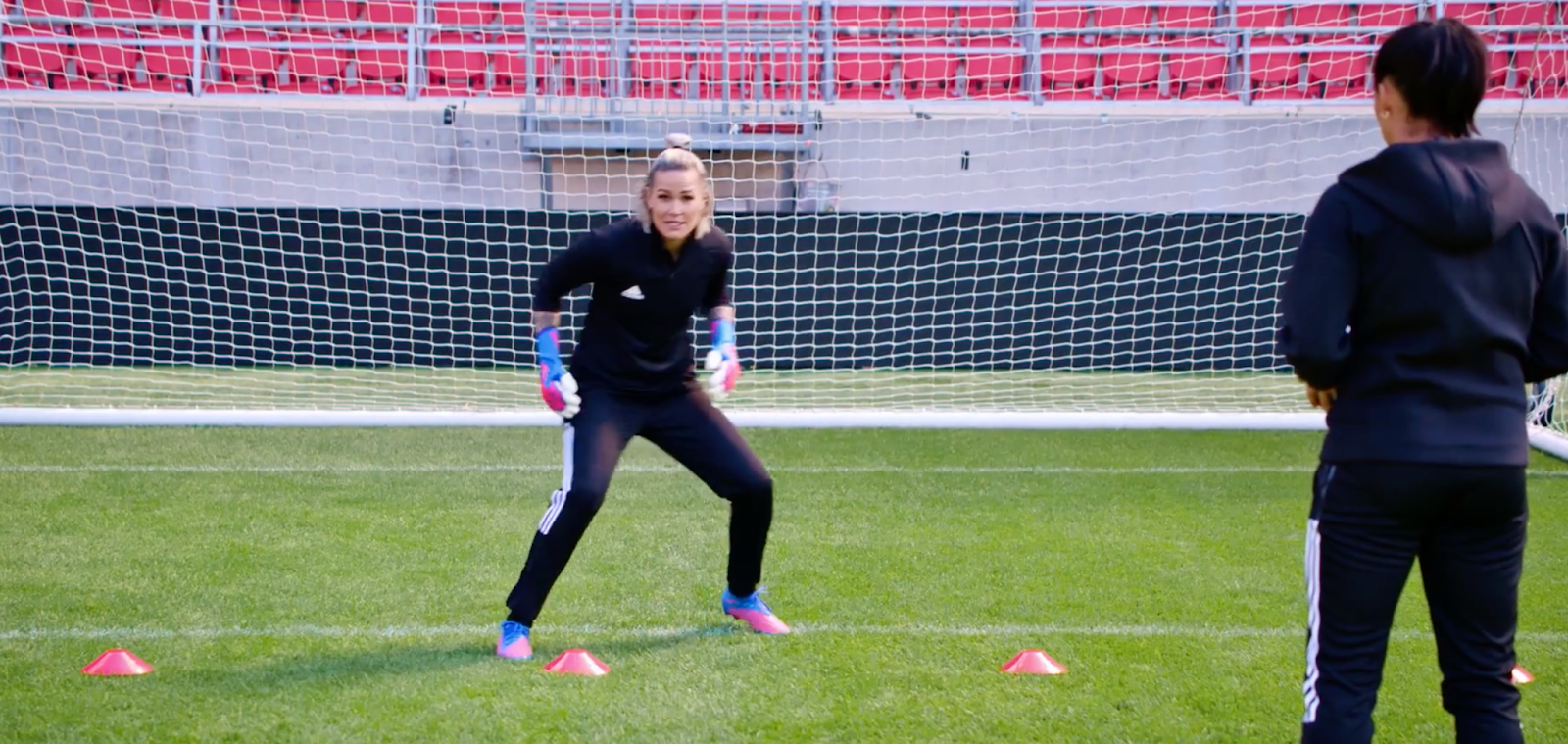Footwork and Balance for Soccer Goalkeepers

Footwork is the glue that holds all of a goalkeeper’s skills together. Learn from Ashlyn Harris on how to dial in your footwork to stop the ball as a goalkeeper and put yourself in a position to be an elite goalkeeper with her footwork drills.
Ashlyn Harris explains why footwork is the key to making great saves, laying out one key drill to help improve your skills
In our article on handling technique, we made the claim that, “Nothing is more important than handling skills for a soccer goalkeeper.”
Now at Versus, we still stand by that comment. But as iconic U.S. goalkeeper, Ashlyn Harris, reminded us in a recent training session — “only keepers with great footwork and balance can fully utilize their handling technique.”
The reason why, in Ashlyn’s words, is “your feet get your hands to the ball.”
So even if you have lightning fast reflexes and amazing handling skills, if you are off balance and out of position due to sloppy footwork, your ability to make a save will be compromised.
Footwork is the glue that holds all of a goalkeeper’s skills together. It’s easy to neglect, however, because it’s a subject that’s not as exciting as practicing diving or distribution. ortunately, you can train footwork alongside other skills.
In this article, we’re going to run through a simple footwork drill that Ashlyn details in an exclusive video training session with Versus. The drill can be used in combination with all of the skills covered in Harris’ course on fundamental goalkeeping skills, including:
If you would like to access more of Ashlyn’s amazing training videos, all you need to do is choose a plan, download the Versus app, and begin.
We have a full library of exclusive video sessions from some of the biggest names in soccer. In addition to Ashlyn Harris, a Versus subscription gives you access to U.S. soccer legends like Kelley O’Hara, Ali Krieger, and renowned technical coach, David Copeland-Smith.
But Versus includes much more than only videos and lessons. Through our conversational AI-based technology—you can ask questions to our roster of elite athletes and world-class coaches.
And because of our exclusive conversational AI technology, you could be watching Harris’s video on footwork, and then click “Talk to Ashlyn” in the app, and ask a question like, “How do you decide whether to punt or throw?” Or, “How do you recover after making a mistake?” You will get a reply just seconds later, utilizing one of Harris’ 200+ pre-recorded answers, covering 22 topics.
Now, let's get back to Ashlyn’s drill to help soccer goalkeepers develop great footwork and balance.
Footwork Drill for Goalkeepers
To set up for the drill, you’ll need four cones and a partner.
Evenly space the cones about 6 yards apart (soccer goalposts are 8 yards apart), like this.

Get into a nice balanced set position, like this.

Then move out to one of the cones, while maintaining great footwork, balance, and body positioning (we’ll explain the finer details in a moment).

Get back to your set position (still focusing on perfect movement). Then your partner delivers the ball and you catch it.

Aim for three sets of 20 reps per session, alternating between cones for each rep.
The framework of this drill is simple. But as we’ll cover below, it incorporates several essential goalkeeping skills and has a lot of scope for progressions.
Let’s start by taking a look at one of the most important aspects of footwork—balance.
Balance is Key for Great Footwork
“Balance is a key aspect in everything we do as a goalkeeper,” explains Harris.
In essence, the purpose of focusing on footwork is to swiftly get from A to B as a goalkeeper, while maintaining a state of perfect balance.
“I have to be in a position where I can move left, right, up, or down at any given moment,” states Ashlyn. “That means my feet have to stay tied to the ground, with no large steps.”
The two keys to balance are to take small steps and always stay square to the ball.
Taking large steps as a keeper leaves you in a compromised position, like this.

Imagine trying to make a save from that stance.
Unless the ball comes right to your hands, the best you could hope for is an unbalanced lunge, which is likely to result in a rebound. If you end up in a position like this in game, the striker will know they have you beat, and potentially have an easy shot on goal.
Not staying square to the ball results in a similar problem.
If you turn your body to move, like this.

You will be unable to recover if the forward you are chasing does a quick cross to their teammate on the other side of the field.
Take a look at how low, balanced, light on her feet, and square to the ball Ashlyn is in the picture below, as she moves between the cones.

Body Positioning - Stay Square and Maintain your Angles
When demonstrating proper body positioning in the video, Harris frequently refers to “angles” and “staying square to the ball.”
What she’s describing, is the technique by which a goalkeeper can change direction without turning around.
When running through the drill, focus on taking small, fast steps. Stay low, with soft knees. And change direction by adjusting angles, not turning your body.
Here’s Ashlyn demonstrating her body angle at one of the closer cones.

And further away.

Then changing angles on the opposite side.

The key to great body positioning as a goalkeeper is maintaining a discipline of staying square to the ball throughout every movement—not just when the ball gets close.
It’s tempting to turn and run when you need to cover some ground quickly. Say, to move from one side of the goal to the other. But if you do, chances are that when you arrive, you will be off balance and not in a position to make a save.
Keepers dial in proper footwork during practice so that this agile and balanced way of moving becomes second nature. In time, it will be just as fast as your running. Then, you will be sure to arrive in the right spot on time, in the optimal position to make a save.
As always, this takes practice and repetition. Also, you will need to practice footwork in combination with other goalkeeping skills.
Progressions and Additional Skills
You can make this drill more challenging by increasing the difficulty of moving between cones and incorporating additional goalkeeping skills.
To make moving between cones more difficult, number each one, then get your partner to call out a number for each rep. If you are using four cones, 1 & 4 would be the outside cones, while 2 & 3 would be the inside.
So when your partner calls “Four,” you move to the corresponding cone, then back to your set position to catch. To add another element, try touching the cone with your hand on each rep. “Now you have to go from an uncomfortable position, back into a set position ready to react,” states Harris.
These additions might sound simple. But most players are surprised how quickly their newly learned footwork deteriorates with additional elements to focus on.
Next, try incorporating different goalkeeping skills.
This might include getting your partner to deliver the ball for a high, mid-range, and low catch, so that you can practice each handling technique. You can even incorporate diving and distribution skills.
Check out where Ashlyn is up to by the end of the session.

Remember, the goal of this drill is to dial in perfect footwork and balance. It’s important to make the drill progressively more difficult, but not at the expense of your footwork breaking down.
Key Takeaways
“Never neglect your feet,” warns Harris.
“Your feet are always what gets you to the ball as a goalkeeper,” she explains. “So start learning to move very fast. But most importantly—very balanced.”
To ensure that you don’t neglect your footwork, incorporate Ashlyn Harris’ footwork drill into your practice regularly.
It is a simple drill that can be combined with other fundamental goalkeeping skills, making it an efficient and valuable addition to your training.
When running through the drill, stay aware of the key components of good footwork:
- Take small steps
- Always maintain your balance
- Keep shoulders square to the ball
This might sound simple, but done at a fast pace in combination with other goalkeeping skills, it will be a challenge to maintain perfect footwork and balance.
To watch Ashlyn Harris’s full training video on developing great footwork for soccer goalkeepers—simply select a plan, download the Versus app, and start learning.
If you want to learn more about developing your mindset, improving reactions and reflexes, or reading the game, head over to Versus and check out our Game Plans. Any of our packages will get you access to our lessons, plus tons of other training sessions, interactive content, and more.
Keep up with the Versus community.
Get notified of new content releases, new features, and much more!
Sign up to get new article notifications
Join our newsletter for new course release updates and get early access to upcoming course trailers.










